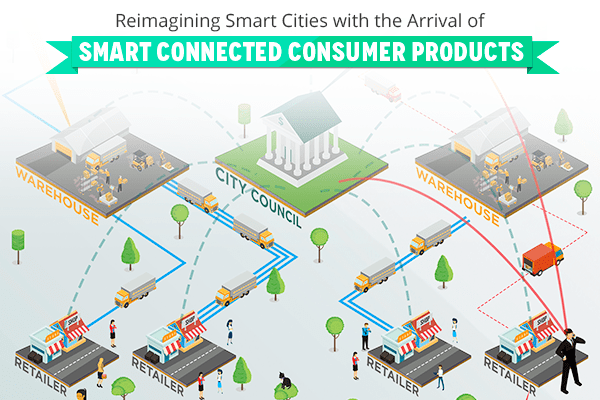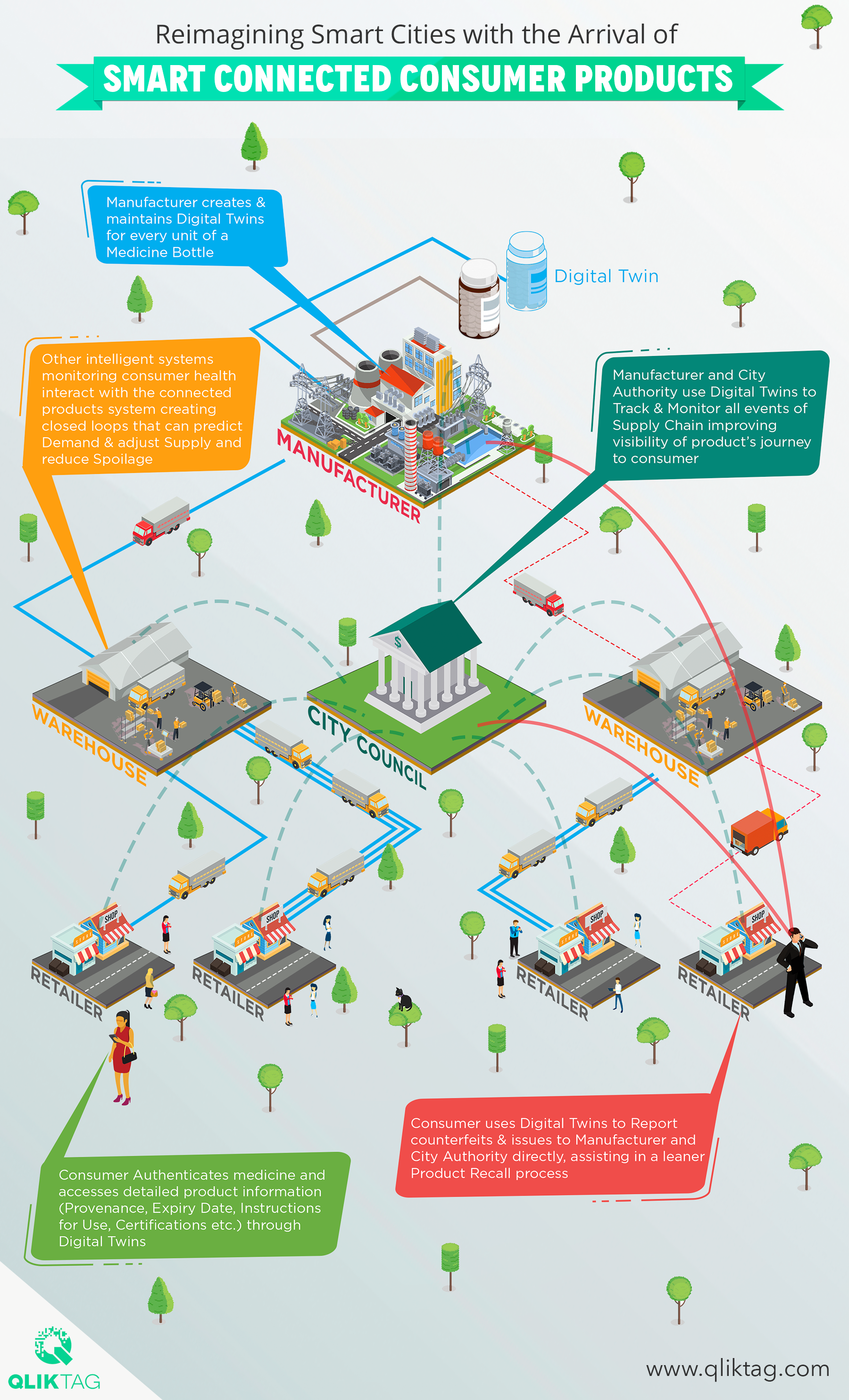Here is an infographic showing “How a Smart City of the future could function with the advent of Smart Connected Products.”
We are fast moving towards a future where cities will feature hundreds and thousands of smart connected objects, talking to each other, exchanging and producing meaningful data and insights, basically reshaping the urban landscape into intelligent and autonomous systems. Internet of Things will be at the heart of this technological transformation, as sensors and digital tags will find their way into various physical city infrastructure, monitoring traffic, weather, crime and even rat infestations! However, it’s not just hardware IoT and sensors that will provide city planners and authorities to gain more visibility into the working and management of a city.
Smart connected products or ordinary consumer products tagged with digital ID’s and digital twins can open up new dimensions in how we imagine Smart Cities to function.
For the sake of painting a picture of the role of connected products within Smart Cities, let’s consider a pharmaceutical company supplying critical drugs to a city. Enabling every drug product at batch and serial item level to have a digital twin of its physical self will allow for exchange of product related data to happen between manufacturer, the supply chain, the city authorities, end consumers and the products themselves.
Read on to see how the pharmaceutical industry could look like in the not so distant future.
Smart Logistics & Traceability
Digitally tagged consumer products such as medical products will paint a clearer picture of each item’s journey from the manufacturing facility to the hands of a customer, resulting in intelligent movement of products characterized by autonomy. Each time a product moves, whether it’s from the factory to a truck, or from the truck to a warehouse, its location and movement will be logged against its digital twin in real time with the help of a scanner, RFID reader, smartphone or other connected devices.
So when situations arise where brands or smart city authorities become aware of substandard or defective products in circulation, the process of factoring on the production source for them and a faster and leaner product recall will become easier by tracing back to the relevant point in the product’s journey.
Smarter Production & Distribution Channels
Smart connected products will help in procuring the right amount in the right place at the right time. Complete visibility at all events of the supply chain will allow brands to better predict demand in respective locations in a city. Better predictive ability will help them to create seamless intelligent systems capable of efficiently managing production and distribution channels, ultimately leading to reduction of wastage by preventing accumulation of unused medicines.
In fact, brands will be able to predict demand on a much larger scale than before. They will anticipate when a particular medicine is supposed to run out at the city-level and trigger production cycles for the particular product.
Smarter response to Public Health crises
With IoT powered smart products, the engagement and the monitoring does not stop at the customer level. Even after the product leaves the shelf, customers can input valuable data through the digital twins which can be mined into to tailor smarter responses to public health emergency situations.
For example, city authorities will be aware of exactly how many medical products are in inventories across the city by keeping track of their movement across every touchpoint in the supply chain. In situations where a contagious disease breaks out, public health officials will be instantly alerted by hospitals that are also hooked onto the network. By keeping track of the quantity and location of stocks of medicines dispersed across city, public health officials will always be prepared to tackle such high priority situations as they can more efficiently assess and redirect required medicines to appropriate locations.
Even smarter, cities of the future could be prepared for seasonal illnesses by predicting their onset based on algorithms derived from a mix of data from weather forecasts, hospital reports and product supply chains.
Smarter Citizens
Digital twins will give rise to smarter citizens, who will be capable of using smartphones to digitally interact with the packaging in order to obtain accurate information pertaining to authenticity, ingredients, color coded expiry dates, instructions for use (IFU) etc. Not only will digital twins of medical products enforce transparency, but they will help in improving health literacy by weeding out counterfeits and providing easy-to-read and user-friendly formats to dispense IFUs.
Medical products empowered by IoT will also lay the foundations for a multiway communication channel between consumers, manufacturers, and city authorities, especially aiding researchers to collect and analyze feedbacks for clinical trials and development of new cures.
Smarter ways to tackle Counterfeits
Falsified medical products take the top spot in the fraudulent products market, being worth US$163 billion to $217 billion per year. Falsified, substandard and unlicensed medicines and medical devices pose a serious threat to public health. Counterfeit medicines are on the rise and no place remains untouched by them.
However, medical products with digital twins can have vast implications in fighting the war against falsified medical products. The sophisticated digital tags on these products can act as a unique identifier, at the same time providing a user-friendly way to verify their authenticity. Both retailers and consumers just need to authenticate the product using the digital tag which will allow it to confirm the product’s genuineness by running it against an online database.
Going one step further by taking advantage of a highly connected ecosystem, fraudulent products can instantly be reported by consumers directly to manufacturers and city authorities. City authorities can thus keep track of regions in the city reporting counterfeits and crack down on the sources for such illegal operations.
The goal of smart cities is to create intelligent urban spaces and infrastructures to improve the lives of their citizens. But the first step towards this goal is to set up digital twins for products to bring them onto the Internet of Things platform. For these automated and intelligent systems would be impossible without various products generating and transmitting data about themselves. At this point, we have barely scratched the surface with IoT’s potential to create smarter cities, and smart connected products will lead the way in laying the foundation for the cities of the future.


Recent Comments